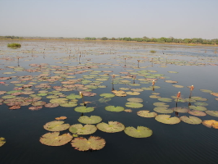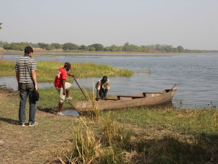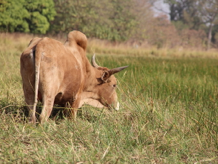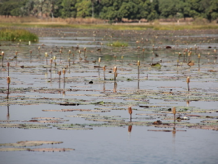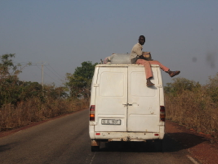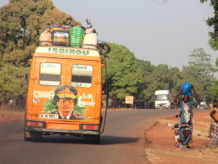From Houston to Sydney 2013

West Africa
2014
You would never know that Burkina Faso’s second largest city, Bobo-Dioulasso, has a population of half a million people. Yes, it does sprawl across quite vast distances, but in many parts of the city the atmosphere is more like a large village than an urban centre.
That was certainly the case in the area where we spent the first part of this morning. We set out from our hotel at 8:30 am after having enjoyed hot showers and a great breakfast that featured excellent, long, crusty mini-bread rolls.
Our first stop was at the old mosque in the historical heart of Bobo-Dioulasso. Although the oldest mosque in the city, it was built relatively recently (in 1893), and it looked fabulous in the golden sunlight of the early morning. Built in the Sahel mud-brick style of architecture, with conical towers and wooden struts, the building had a harmony of style that was instantly captivating.
There was no problem for non-Muslims to enter the mosque, so having been invited to do so, Andrew and I removed our shoes and followed a ‘guide’ through the various sections of the building. Our walk finished on the roof, where we had wonderful views of the two main towers, one for men (with five rooms, one on top of the other) and the other for women (four rooms, also stacked) who wanted a place to meditate in solitude.
Across the road from the mosque was the oldest part of the city, and its network of alleyways and courtyards was fascinating to explore. The old town is divided into four clearly differentiated zones – the animist quarter, the Muslim quarter, the history-tellers’ quarter and the blacksmiths’ quarter. We explored each of these areas in turn.
The animist area featured many little shrines where fetishes were offered and animals (mainly chickens, judging by all the feathers) had been sacrificed. Crossing a narrow laneway brought us to the Muslim quarter, which included Bobo-Dioulasso’s oldest building, a house that was built in the 11th century and which is used today for women’s gatherings.
In all the zones of the old city, improvisation was a common feature, with old tin cans being recycled into children’s toys and jewellery, scrap metal being fashioned to ornaments, and as you would find in most rural villages in West Africa, a heavily polluted river being used both for washing and for raising catfish.
The walk around the old town was wonderful, but after that it was time to explore the newer part of Bobo-Dioulasso, and especially the Big Market (Grand Marché). Covering the area of several city blocks and housed under several substantial large covered shelters, the market was a remarkably hassle-free place to explore a typical West African market on a grand scale. It was all here – clothes, fruit, vegetables, meat, tailors, and much more, all arranged in neat surprisingly rows and separated by narrow, crowded laneways. It was friendly, colourful, and in the case of the meat and fish sections, quite aromatic.
An excursion out of Bobo-Dioulasso was planned for the afternoon, so at about 11:00 am we began the 90 kilometre drive south-west to the town of Banfora. Banfora is a major centre of sugar production, and as we entered the town from the north-east, we drove past several large sugar cane fields with quite capital intensive travelling irrigators hard at work.
We arrived in Banfora at 12:30 pm, and stopped for lunch in the very pleasant courtyard garden of the Hôtel Canne à Sucre. Andrew had a beef curry while I had spaghetti carbonara, and we both went away feeling very happy and satisfied by the quality of the food.
The reason we had come to Banfora was to go to Lake Tengréla, about 7 kilometres to the west of the town. The lake is famous for its hippos, and the dry season (i.e. now) is supposed to be the best time of year to see them. Getting to the area where the hippos are found involves a ride in a small wooden pirogue, in this case one that is rowed. It was a lovely experience being out on the lake, enjoying the gentle breeze across the smooth waters on this hot day, with the only sounds being the soft brushing of the water lilies against the side of the boat and the scraping and splashing sound of a large tin can on the bottom of the boat as Mama frantically scooped out the water that was leaking into the boat through the hull.
Sadly, the hippos were nowhere to be seen today – that is always the risk with wildlife, so there were no hard feelings. Having said that, it was a long way to go for a short boat trip, and if I were reorganising the itinerary with the benefit of hindsight, I think I would explore Bobo-Dioulasso in the morning, and then drive to Ouagadougou (our next stop) in the afternoon. That would shorten our time in Burkina faso by a day, thus reducing the visa cost from 94,000 francs each to “just” 25,000 francs. Alternatively, if I were to include Banfora, I would miss Lake Tengréla and go instead to either the Dômes de Fabedougou or the rock formations at Sindou, both of which seem more spectacular and more predictable than the hippos.
We returned to Bobo-Dioulasso, arriving at about 5:15 pm. Despite not seeing the hippos, it was a good day that provided an excellent introduction to the look and feel of Burkina Faso – something that both Andrew and I are enjoying so far very much indeed.

Day 15 - Bobo-Dioulasso, Burkina Faso
Saturday
11 January 2014





































